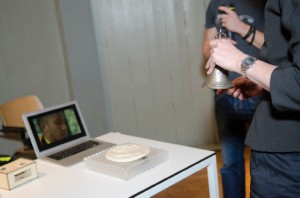It is often the case that a museum has access to technology (for example, from a previous exhibition or student project) that they would like to repurpose. Adjusting the technology or matching it with appropriate content often presents a challenge. In this case, there were several smart objects (prototypes developed within meSch) that could be re-used for other contexts.This case study details a day-long co-design session (Exploratory Lab), which brought a group of Dutch cultural heritage professionals together with meSch designers to explore how previously developed meSch prototypes could be re-appropriated to support other museum experiences.
The participating cultural heritage professionals were asked beforehand to bring with them a museum artefact (either replica or authentic) and content associated with the artefact from their own institutions’ collections. At the start of the workshop, five smart objects (prototypes) built by the meSch team were introduced and demonstrated to the cultural heritage professionals.
The cultural heritage professionals were then asked to choose the most appropriate smart object for the content they wanted to use. On choosing a prototype, each cultural heritage professional collaborated with one of the designers of the prototype that he/she had chosen.

While discussing ideas, the groups used different co-design methods including Card Metaphors, Narrative Scenarios and Storyboards to tease out how the content could be portrayed through the smart objects.They were also asked to think about how the prototypes could be physically re-designed in terms of form factor and material to suit their needs. To this end, Low-Fidelity Prototyping helped the groups imagine the physical capabilities of the objects in linking the content to the interaction possibilities.
During the workshop, facilitated by the meSch team at the Waag Society in Amsterdam, six use cases for the digitally-enhanced prototypes were developed for creating personalised museum experiences; generating guided and wayfinding experiences; and augmenting physical museum artefacts with digital information. At the end of the workshop each of the repurposed smart objects was demonstrated to the other participants.
Additional Information
If you would like to find out more about this case study, you can read this blog post and look up photos from the exploratory lab. The adaptation of the Way Finder prototype for a historical house in the form of a pie dish is presented in detail in a paper recently approved for presentation at a prestigious conference (link coming soon!).
Cultural Heritage Professionals’ Testimonials:
The exploratory lab at WAAG was very important, because it meant we could be involved in the process of thinking about what is needed and it allowed us to think about all of the different ways that you could use technology. It was also really great to see the perspective of the other museums.
…. what meSch could offer in this situation, is tech partners who could drive the ideas past paper and pen.
For me, the prototypes are a means of creating a dialogue because if you proposed something to a museum then they can say I like this or I would have liked it if it had done this. So then it becomes less open but it triggers other questions because it is something you can use, rather than it being just a discussion in words where everything is possible and it is difficult to get to new ideas but if you use something then it triggers new ideas. So for me the prototypes are not end points but they are a means of getting into a dialogue together.





